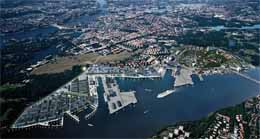Sustainable urban development - Royal Sea Port – City of Stockholm
(Norra Djurgårdsstaden)

Sweden’s largest city district, Royal Sea Port(SRS), is to be developed in central Stockholm over the coming years. It stretches from Hjorthagen in the north, through the port area, to Loudden in the south. This urban development contains plans for 10,000 new residences and 30,000 new workspaces and can be compared with other European urban development projects, such as those in Copenhagen, Oslo and Hamburg. Planning work started in the early 2000s and the new city district is fully developed around 2025.
Based on the experiences from Hammarby Sjöstad, an urban district, with a well known environmental program, the city have raised a vision to create a sustainable urban district in the middle of Stockholm. The new development area will focus on sustainable transport solutions, efficient building processes, energy conservation and energy efficiency.
The three overall environmental targets for Stockholm Royal Seaport are:
- By 2020, carbon emissions are lower than 1.5 tonnes per person and year
- By 2030, Stockholm Royal Seaport is free of fossil fuels
- Stockholm Royal Seaport is adapted to future climate changes
Industrial Ecology, KTH have a joint research project with the City of Stockholm based on research and support to the process and discussions in SRS how to develop smart climate and sustainable urban districts. Our research is based on our following up of Hammarby Sjöstad and international experiences from urban development around the world. The project started 2009 and will continue until 2013 in the present phase. In the project Industrial Ecology will:
- Deepen the analyze of Hammarby model, a system model for local energy production based on waste, sludge, recovering of heat from waste water and district heating.
- Develop scenarios for the whole urban district in order to investigate and visualize the vision and the overarching environmental goals for the urban district.
- Organize “ workshops for the future “ focusing on strategically issues concerning climate smart living and innovations for sustainable urban development.
- Create a model for dynamic following up system of based on visions and the overarching environmental goals. The dynamic following up model should include follow up system on three levels, individuals, buildings and urban district level.
Project funded by City of Stockholm and KTH.
Project leader:
Nils Brandt, associate professor, Industrial Ecology, KTH
Project team:
Nils Brandt
Louise Årman
Stefan Johansson; PhD candidate
